
(a)
Find the smallest combined mass m of the bucket for the block C will remain at rest.
(a)
Answer to Problem 8.119P
The smallest combined mass m of the bucket is
Explanation of Solution
Given information:
The mass of the block C is
The coefficient of static friction is
The coefficient of kinetic friction is
The drum B is frozen and cannot rotate.
Calculation:
Show the free-body diagram of the drum B as in Figure 1.
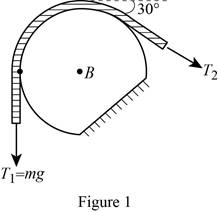
Find the angle of the belt wounded around the drum as follows;
Find the tension
Substitute mg for
Here, the acceleration due to gravity is g.
Consider the value of acceleration due to gravity is
Show the free-body diagram of the block C as in Figure 2.
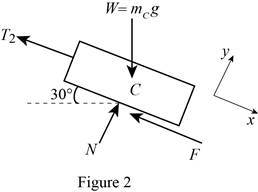
At rest, the cable slips on the drum. The motion impending is along the x-axis.
Substitute
Resolve the horizontal component of forces.
Substitute 100 kg for
Find the friction force (F) using the relation.
Substitute 0.35 for
Resolve the vertical component of forces.
Substitute
Therefore, the smallest combined mass m of the bucket is
(b)
Find the smallest combined mass m of the bucket for the block C start moving up the incline.
(b)
Answer to Problem 8.119P
The smallest combined mass m of the bucket is
Explanation of Solution
Given information:
The mass of the block C is
The coefficient of static friction is
The coefficient of kinetic friction is
The drum B is frozen and cannot rotate.
Calculation:
Show the free-body diagram of the drum B as in Figure 3.
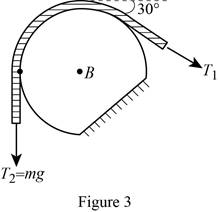
Find the angle of the belt wounded around the drum as follows;
Find the tension
Substitute mg for
Show the free-body diagram of the block C as in Figure 4.
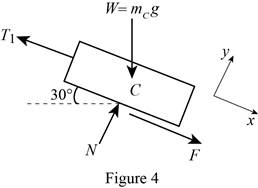
When the block start moving up the incline;
No slipping occurs at block and drum. The motion impending is against the x-axis.
Substitute
Resolve the horizontal component of forces.
Substitute 100 kg for
Find the friction force (F) using the relation.
Substitute 0.35 for
Resolve the vertical component of forces.
Substitute
Therefore, the smallest combined mass m of the bucket is
(c)
Find the smallest combined mass m of the bucket for the block C continue moving up the incline at constant speed.
(c)
Answer to Problem 8.119P
The smallest combined mass m of the bucket is
Explanation of Solution
Given information:
The mass of the block C is
The coefficient of static friction is
The coefficient of kinetic friction is
The drum B is frozen and cannot rotate.
Calculation:
Show the free-body diagram of the drum B as in Figure 5.
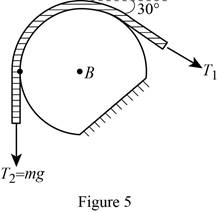
Find the angle of the belt wounded around the drum as follows;
Find the tension
Substitute mg for
Show the free-body diagram of the block C as in Figure 6.
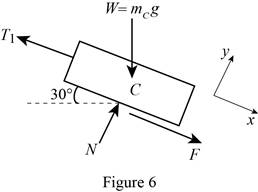
When the block start moving up the incline;
No slipping occurs at block and drum. The motion impending is against the x-axis.
Substitute
Resolve the horizontal component of forces.
Substitute 100 kg for
Find the friction force (F) using the relation.
Substitute 0.25 for
Resolve the vertical component of forces.
Substitute
Therefore, the smallest combined mass m of the bucket is
Want to see more full solutions like this?
Chapter 8 Solutions
Connect 1 Semester Access Card for Vector Mechanics for Engineers: Statics and Dynamics
- In the bending of a U-profile beam, the load path passes through the torsional center C, causing a moment of 25 kNm at the cross-section under consideration. Additionally, the beam is subjected to an axial tensile force of 100 kN at the centroid. Determine the maximum absolute normal stress.(Check hint: approximately 350 MPa, but where?)arrow_forward### Make an introduction to a report of a rocket study project, in the OpenRocket software, where the project consists of the simulation of single-stage and two-stage rockets, estimating the values of the exhaust velocities of the engines used, as well as obtaining the graphs of "altitude", "mass ratio x t", "thrust x t" and "ψ × t".arrow_forwardA 6305 ball bearing is subjected to a steady 5000-N radial load and a 2000-N thrust load and uses a very clean lubricant throughout its life. If the inner race angular velocity is 500 rpm find The equivalent radial load the L10 life and the L50 lifearrow_forward
- Where on the below beam is the Maxiumum Slope likely to occur? C A; Атят Barrow_forwardWhat is the moment of Inertia of this body? What is Ixx, Iyy, and Izzarrow_forwardi need the The shaft is supported by a smooth thrust bearing at AA and a smooth journal bearing at BB. Draw the shear diagram for the shaft. Follow the sign convention.arrow_forward
- 4- In the system shown in the figure, the water velocity in the 12 in. diameter pipe is 8 ft/s. Determine the gage reading at position 1. Elevation 170 ft 1 Elevation 200 ft | 8 ft, 6-in.-diameter, 150 ft, 12-in.-diameter, f = 0.020 f = 0.020 A B Hints: the minor losses should consider the contraction loss at A and the expansion loss at B.arrow_forwardWhat is the moment of Inertia of this body? What is Ixx, Iyy, and Izzarrow_forwardConsider a glass window (Hight = 1.2 m, Width = 2 m). The room thatfaces the window are maintained at 25 o C. The average temperature ofthe inner surface of the window is 5 o C. Calculate the total heat transferrate from through the window a) IdenCfy what type(s) of convecCon is important (circle one). • external forced (Chapter 7)• internal forced (Chapter 8)• natural convecCon (Chapter 9)• boiling and condensaCon (Chapter 10)b) IdenCfy the necessary equaCon(s) needed to solve the problem. c) IdenCfy important fluid properCes you need to solve the problem. d) Calculate the total heat transferred.arrow_forward
- Water is condensing on a square plate (0.5 m x 0.5 m) placed verCcally. If the desired rate ofcondensaCon is 0.016 kJ/s, determine the necessary surface temperature of the plate at atmosphericpressure. Assume the film temperature of 90 o C for evaluaCon of fluid properCes of water and thesurface temperature of 80 o C for the evaluaCon of modified latent heat of vaporizaConarrow_forwardWater at 20 o C enters the 4 cm-diameter, 14 m-long tube at a rate of 0.8 kg/s. The surfacetemperature of the pipe is maintained at 165 o Cby condensing geothermal stream at the shellside of the heat exchanger. Use water properCesat 85 o C for all calculaCons.(a) Show that the water flow is turbulent and thermally fully developed. (b) EsCmate the heat transfer coefficient for convecCve heat transfer from the pipe to the water. For a fully developed turbulent flow within the smooth pipe, the Nu number can becalculated from the following equaCon:(c) Calculate the exit temperature of the water. (d) Share your opinion on whether the use of water properties at 85°C is appropriate. Yes or No because:arrow_forwardConsider a hot automotive engine, which can beapproximated as a 0.5-m-high, 0.40-m-wide, and 0.8-m-long rectangular block. The bottom surface of the block isat a temperature of 100°C and has an emissivity of 0.95.The ambient air is at 20°C, and the road surface is at25°C. Determine the rate of heat transfer from the bottomsurface of the engine block by convection and radiationas the car travels at a velocity of 80 km/h. Assume theflow to be turbulent over the entire surface because of theconstant agitation of the engine block. a) Calculate convective heat transfer coefficient (h). b) Calculate the total heat transfer ratearrow_forward
 Elements Of ElectromagneticsMechanical EngineeringISBN:9780190698614Author:Sadiku, Matthew N. O.Publisher:Oxford University Press
Elements Of ElectromagneticsMechanical EngineeringISBN:9780190698614Author:Sadiku, Matthew N. O.Publisher:Oxford University Press Mechanics of Materials (10th Edition)Mechanical EngineeringISBN:9780134319650Author:Russell C. HibbelerPublisher:PEARSON
Mechanics of Materials (10th Edition)Mechanical EngineeringISBN:9780134319650Author:Russell C. HibbelerPublisher:PEARSON Thermodynamics: An Engineering ApproachMechanical EngineeringISBN:9781259822674Author:Yunus A. Cengel Dr., Michael A. BolesPublisher:McGraw-Hill Education
Thermodynamics: An Engineering ApproachMechanical EngineeringISBN:9781259822674Author:Yunus A. Cengel Dr., Michael A. BolesPublisher:McGraw-Hill Education Control Systems EngineeringMechanical EngineeringISBN:9781118170519Author:Norman S. NisePublisher:WILEY
Control Systems EngineeringMechanical EngineeringISBN:9781118170519Author:Norman S. NisePublisher:WILEY Mechanics of Materials (MindTap Course List)Mechanical EngineeringISBN:9781337093347Author:Barry J. Goodno, James M. GerePublisher:Cengage Learning
Mechanics of Materials (MindTap Course List)Mechanical EngineeringISBN:9781337093347Author:Barry J. Goodno, James M. GerePublisher:Cengage Learning Engineering Mechanics: StaticsMechanical EngineeringISBN:9781118807330Author:James L. Meriam, L. G. Kraige, J. N. BoltonPublisher:WILEY
Engineering Mechanics: StaticsMechanical EngineeringISBN:9781118807330Author:James L. Meriam, L. G. Kraige, J. N. BoltonPublisher:WILEY





